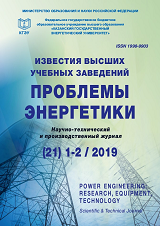
«Power engineering: research, equipment, technology» is a peer-reviewed scientific publication, which covers fundamental and applied research, as well as discussion issues on power engineering and related industries and science.
The founders of the journal are: Kazan State Power Engineering University and the Ministry of Education of the Russian Federation. The journal is registered in the Ministry of Press, TV and Radio Broadcasting and Mass Communications - PI No. 77-7322 of 19.02.2001.
The international standard serial number of the journal (ISSN) is 1998-9903. Subscription index in the "Newspapers. Journals» Agency of «Rospechat» printers - 79586. Periodicity 6 issues per year (with double editions).
The journal is included to the List of peer-reviewed scientific publications, in which the main scientific results of thesis for the scientific degree of philosophy doctor (PhD) of sciences, for the academic degree of a doctor of science should be published.
The journal publishes papers corresponding to a group of qualifications :
05.14.00 - "Power engineering"
Power systems and complexes
Electric stations and electric power systems
Industrial Heat and Power Engineering
Power plants based on renewable energy
Thermal power plants, their power systems and units
05.09.00 – “Electric engineering”
Electromechanics and electrical apparatus
Electrotechnical materials and products
Electrotechnical complexes and systems
Lighting technology
05.11.00 - Instrument making, metrology and information-measuring devices and systems
Devices and methods of measurement
Instruments and methods for monitoring the environment, substances, materials and products
Information-measuring and control systems in power engineering
The Journal publishes the results of open scientific research carried out by scientists of scientific institutions, higher educational institutions, other organizations and citizens conducting research in the form of a personal initiative. The following materials are accepted for publication: original articles; scientific reviews; reviews; short messages; reference materials. To support creative youth, the rubric "Towards the Defense of a Thesis" is organized. Language of publications: Russian, English.
The journal is included in the system of the Russian Scientific Citation Index (RINC), in the international subscription catalog of the periodicals "Ulrich's Periodicals Directory". The journal's issues are posted on the website of the Scientific Electronic Library (NEB).
Current issue
ELECTROTECHNICAL COMPLEXES AND SYSTEMS
ELECTRICITY
ENERGY SYSTEMS AND COMPLEXES
THEORETICAL AND APPLIED HEAT ENGINEERING
Announcements
2024-04-27
Мы празднуем юбилей!
Вестник политехнического института Таджикского технического университета имени академика М.С. Осими
Уважаемые Эдвард Юнусович и Ирина Гареевна!
Примите самые искренние и теплые поздравления по случаю знаменательного юбилея – 25-летия со дня основания журнала "Известия высших учебных заведений. ПРОБЛЕМЫ ЭНЕРГЕТИКИ". В этот торжественный момент мы от всей души хотим выразить восхищение вашими достижениями и вкладом в научное развитие общества. Ваш журнал стал важнейшим источником научных знаний и новаторских идей в области энергетики. Его страницы сохранили историю развития отрасли, отражая ключевые тенденции, переломные моменты и значимые достижения.
Журнал непрерывно служит платформой для обмена знаниями между ведущими учеными, инженерами и экспертами, способствуя трансляции научных исследований в реальную практику. Это не просто издание, это маяк для исследователей, стремящихся к новым открытиям и инновациям в сфере энергетики.
Отдельные слова благодарности мы хотели бы адресовать главному редактору и второму главному редактору, редакционной коллегии и всем авторам, чей труд и преданность делу делают журнал лучшим в своем классе. Ваше непреклонное стремление к совершенству и научной точности заслуживает высочайшего признания. Пусть будущие годы принесут журналу еще больше ярких публикаций, открывающих новые направления исследований и способствующих глобальному развитию энергетической отрасли. Желаем вам расширения международного сотрудничества, укрепления научного сообщества и достижения новых высот в научном мире.
С 25-летием, дорогие коллеги! Пусть каждый год работы журнала будет отмечен значимыми событиями и открытиями, а ваш вклад в развитие науки будет всегда оценен по достоинству. Вместе к новым успехам и победам в науке и образовании!
Главный редактор журнала «Вестник политехнического института Таджикского технического университета имени академика М.С. Осими» д.э.н., профессор, академик Международной инженерной академии Авезов А.Х.
| More Announcements... |











